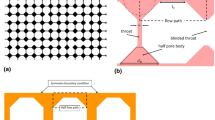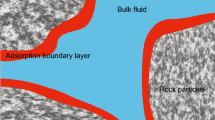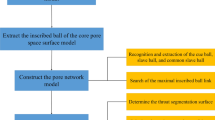Abstract
Describing different transport phenomena through porous media at micro- and mesoscale represents a convenient pre-step in experimental characterization for materials. A detailed study of transport properties in porous materials is required to find suitable microstructural configurations which allow a better performance into mechanic/hydraulic system. Porous media are widely used in several fields of application such as in fuel cells (different layers inside the device) and geological sciences (soil properties). The purpose of the present work is to propose a permeability correlation for digitally created three-dimensional (3D) pore media considering the diameter of the throats connecting the pores within the domain. The 3D samples are generated by means of the Delaunay tessellation and Voronoi algorithm for pore position and throat characteristics, respectively. The model implementation is carried out by using OpenPNM, an open-source pore network modeling package, which has proven to be a powerful tool to compute several transport phenomena for porous media applications. Several samples have been created keeping the pore diameter as a constant, while the throat diameter connecting the pores is changing for a selected range of values in order to analyze the impact of the throat diameter on the permeability. A correlation to compute the permeability as a function of the throat diameter with a coefficient of determination of 95% has been proposed.













Similar content being viewed by others
Abbreviations
- B :
-
Geometric factor
- d b :
-
Characteristic throat diameters at the ‘break-through point’
- F :
-
Conductivity formation factor
- K :
-
Permeability
- L :
-
Domain edge
- n :
-
Iterative value
- p :
-
Pressure
- S :
-
Specific surface area
- u :
-
Velocity
- ϕ T :
-
Throat diameter
- ϕ P :
-
Pore diameter
- ε :
-
Porosity
- η :
-
Dynamic viscosity
- μ :
-
Dynamic viscosity
- \(\nabla\) :
-
Gradient operator
- \(\nabla^{2}\) :
-
Laplacian operator
- DT:
-
Delaunay tessellation
- FC:
-
Fuel cell
- OpenPNM:
-
Open pore network modeling
- SSE:
-
Sum of squared errors
- SEM:
-
Scanning electron microscope
- VA:
-
Voronoi algorithm
References
Adler, P.M., Berkowitz, B.: Effective medium analysis of random lattices. Transp. Porous Media 40, 145–151 (2000). https://doi.org/10.1023/A:1006611011600
Aghighi, M., Hoeh, M.A., Lehnert, W., Merle, G., Gostick, J.: Simulation of a full fuel cell membrane electrode assembly using pore network modeling. J. Electrochem. Soc. 163, 384–392 (2016). https://doi.org/10.1149/2.0701605jes
An, L., Zhao, T.S.: Transport phenomena in alkaline direct ethanol fuel cells for sustainable energy production. J. Power Sources 341, 199–211 (2017). https://doi.org/10.1016/j.jpowsour.2016.11.117
Anbar, S., Thompson, K.E., Tyagi, M.: The impact of compaction and sand migration on permeability and non-darcy coefficient from pore-scale simulations. Transp. Porous Media (2018). https://doi.org/10.1007/s11242-018-1190-3
Andersson, M., Beale, S.B., Espinoza, M., Wu, Z., Lehnert, W.: A review of cell-scale multiphase flow modeling, including water management, in polymer electrolyte fuel cells. Appl. Energy 180, 757–778 (2016). https://doi.org/10.1016/j.apenergy.2016.08.010
Benavente, D., Pla, C., Cueto, N., Galvañ, S., Martínez-Martínez, J., García-del-Cura, M.A., Ordóñez, S.: Predicting water permeability in sedimentary rocks from capillary imbibition and pore structure. Eng. Geol. 195, 301–311 (2015). https://doi.org/10.1016/j.enggeo.2015.06.003
Beutel, A.: Interactive Voronoi Diagram Generator with WebGL (2019). http://alexbeutel.com/webgl/voronoi.html. Accessed 13 Mar 2019
Bubeck, A., Walker, R.J., Healy, D., Dobbs, M., Holwell, D.A.: Pore geometry as a control on rock strength. Earth Planet. Sci. Lett. 457, 38–48 (2017). https://doi.org/10.1016/j.epsl.2016.09.050
Costa, A.: Permeability-porosity relationship: a reexamination of the Kozeny-Carman equation based on a fractal pore-space geometry assumption. Geophys. Res. Lett. 33, 1–5 (2006). https://doi.org/10.1029/2005GL025134
Espinoza-Andaluz, M., Andersson, M., Sundén, B.: Computational time and domain size analysis of porous media flows using the lattice Boltzmann method. Comput. Math Appl. 74, 26–34 (2017a). https://doi.org/10.1016/j.camwa.2016.12.001
Espinoza-Andaluz, M., Andersson, M., Sundén, B.: Comparing through-plane diffusibility correlations in PEFC gas diffusion layers using the lattice Boltzmann method. Int. J. Hydrog. Energy 42, 11689–11698 (2017b). https://doi.org/10.1016/j.ijhydene.2017.02.096
Espinoza, M., Sundén, B., Andersson, M., Yuan, J.: Analysis of porosity and tortuosity in a 2D selected region of solid oxide fuel cell cathode using the lattice Boltzmann method. ECS Trans. 65, 59–73 (2015). https://doi.org/10.1149/06501.0059ecst
Espinoza, M., Andersson, M., Sundén, B.: Predicting transport parameters in PEFC gas diffusion layers considering micro-architectural variations using the Lattice Boltzmann method. Int. J. Energy Res. 41, 565–578 (2016). https://doi.org/10.1002/er.3661
Fazeli, M., Hinebaugh, J., Bazylak, A.: Incorporating embedded microporous layers into topologically equivalent pore network models for oxygen diffusivity calculations in polymer electrolyte membrane fuel cell gas diffusion layers. Electrochim. Acta 216, 364–375 (2016). https://doi.org/10.1016/j.electacta.2016.08.126
Gostick, J., Aghighi, M., Hinebaugh, J., Tranter, T., Hoeh, M.A., Day, H., Spellacy, B., Sharqawy, M.H., Bazylak, A., Burns, A., Lehnert, W., Putz, A.: OpenPNM: a pore network modeling package. Comput. Sci. Eng. 18, 60–74 (2016). https://doi.org/10.1109/MCSE.2016.49
Gostick, J.T., Weber, A.Z.: Resistor-network modeling of ionic conduction in polymer electrolytes. Electrochim. Acta 179, 137–145 (2015). https://doi.org/10.1016/j.electacta.2015.03.126
Katz, A.J., Thompson, A.H.: Fractal sandstone pores: implications for conductivity and pore formation. Phys. Rev. Lett. 54, 1325–1328 (1985). https://doi.org/10.1103/PhysRevLett.54.1325
Matthews, G.P., Moss, A.K., Spearing, M.C., Voland, F.: Network calculation of mercury intrusion and absolute permeability in sandstone and other porous media. Powder Technol. 76, 95–107 (1993). https://doi.org/10.1016/0032-5910(93)80045-C
Mavko, G., Nur, A.: The effect of a percolation threshold in the Kozeny–Carman relation. Geophysics 62, 1480–1482 (1997). https://doi.org/10.1190/1.1444251
Misra, N.N., Martynenko, A., Chemat, F., Paniwnyk, L., Barba, F.J., Jambrak, A.R.: Thermodynamics, transport phenomena and electrochemistry of external field assisted non- thermal food technologies. Crit. Rev. Food Sci. Nutr. 58, 1832–1863 (2018). https://doi.org/10.1080/10408398.2017.1287660
Niya, S.M.R., Selvadurai, A.P.S.: The estimation of permeability of a porous medium with a generalized pore structure by geometry identification. Phys. Fluids 29, 1–11 (2017). https://doi.org/10.1063/1.4977444
Rashidi, S., Esfahani, J.A., Rashidi, A.: A review on the applications of porous materials in solar energy systems. Renew. Sustain. Energy Rev. 73, 1198–1210 (2017). https://doi.org/10.1016/j.rser.2017.02.028
Shojaeefard, M.H., Molaeimanesh, G.R., Nazemian, M., Moqaddari, M.R.: A review on microstructure reconstruction of PEM fuel cells porous electrodes for pore scale simulation. Int. J. Hydrog. Energy 41, 20276–20293 (2016). https://doi.org/10.1016/j.ijhydene.2016.08.179
Sudarsan, B., Ji, W., Adamchuk, V., Biswas, A.: Characterizing soil particle sizes using wavelet analysis of microscope images. Comput. Electron. Agric. 148, 217–225 (2018). https://doi.org/10.1016/j.compag.2018.03.019
Thompson, A.H., Katz, A.J., Raschke, R.A.: Estimation of absolute permeability from capillary pressure measurements, p. 475. Society of Petroleum Engineers, London (1987). https://doi.org/10.2118/16794-MS
Tranter, T.G., Gostick, J.T., Burns, A.D., Gale, W.F.: Pore network modeling of compressed fuel cell components with OpenPNM. Fuel Cells 16, 504–515 (2016). https://doi.org/10.1002/fuce.201500168
Varloteaux, C., Békri, S., Adler, P.M.: Pore network modelling to determine the transport properties in presence of a reactive fluid: from pore to reservoir scale. Adv. Water Resour. 53, 87–100 (2013a). https://doi.org/10.1016/j.advwatres.2012.10.004
Varloteaux, C., Vu, M.T., Békri, S., Adler, P.M.: Reactive transport in porous media: pore-network model approach compared to pore-scale model. Phys. Rev. E Stat. Nonlinear Soft Matter. Phys. 87, 1–15 (2013b). https://doi.org/10.1103/PhysRevE.87.023010
Wang, B., Khoo, B.C., Xie, Z.Q., Tan, Z.J.: Fast centroidal Voronoi Delaunay triangulation for unstructured mesh generation. J. Comput. Appl. Math. 280, 158–173 (2015). https://doi.org/10.1016/j.cam.2014.11.035
Wang, J., Zhao, J., Zhang, Y., Wang, D., Li, Y., Song, Y.: Analysis of the effect of particle size on permeability in hydrate-bearing porous media using pore network models combined with CT. Fuel 163, 34–40 (2016). https://doi.org/10.1016/j.fuel.2015.09.044
Whtaker, S.: Flow in porous media I: a theoretical derivation of Darcy’s law. Transp. Porous Media 1, 3–25 (1986). https://doi.org/10.1007/BF01036523
Xiao, F., Yin, X.: Geometry models of porous media based on Voronoi tessellations and their porosity–permeability relations. Comput. Math Appl. 72, 328–348 (2016). https://doi.org/10.1016/j.camwa.2015.09.009
Xu, P., Yu, B.: Developing a new form of permeability and Kozeny–Carman constant for homogeneous porous media by means of fractal geometry. Adv. Water Resour. 31, 74–81 (2008). https://doi.org/10.1016/j.advwatres.2007.06.003
Yazdchi, K., Luding, S.: Fibrous random materials: from microstructure to macroscopic properties. AIP Conf. Proc. 1542, 1142–1145 (2013). https://doi.org/10.1063/1.4812138
Acknowledgements
The authors kindly acknowledge the financial support from FIMCP-CERA-05-2017 project. Computational and physical resources provided by ESPOL are also very grateful.
Author information
Authors and Affiliations
Corresponding author
Additional information
Publisher's Note
Springer Nature remains neutral with regard to jurisdictional claims in published maps and institutional affiliations.
Rights and permissions
About this article
Cite this article
Encalada, Á., Barzola-Monteses, J. & Espinoza-Andaluz, M. A Permeability–Throat Diameter Correlation for a Medium Generated with Delaunay Tessellation and Voronoi Algorithm. Transp Porous Med 132, 201–217 (2020). https://doi.org/10.1007/s11242-020-01387-z
Received:
Accepted:
Published:
Issue Date:
DOI: https://doi.org/10.1007/s11242-020-01387-z




